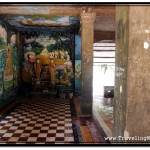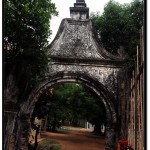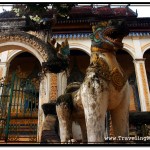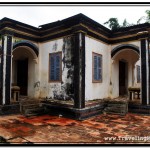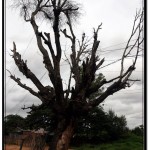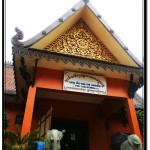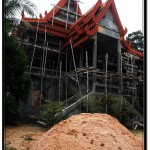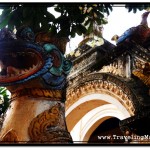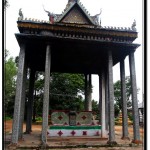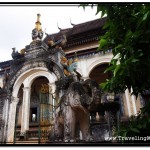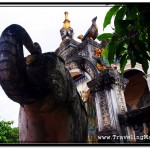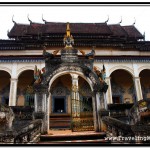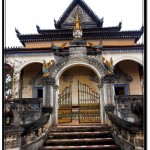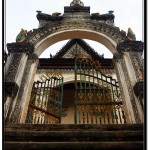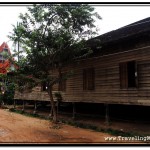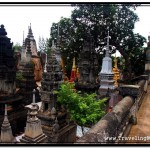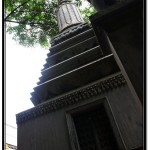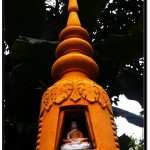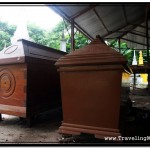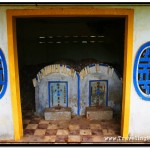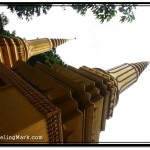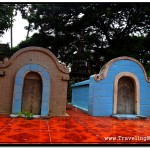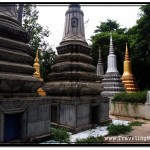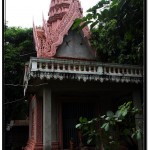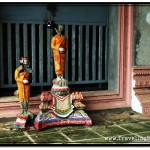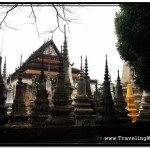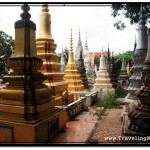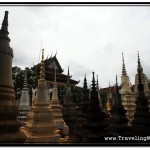Tag: Wat Bo
Sticky Rice Cakes
As I was walking around Wat Bo with my camera hung around my neck, I noticed smoke rising from underneath the metal roof at an open area of the temple grounds. There were several middle aged men underneath the roof and given that it was September when temperatures in Cambodia reach extremely high levels, I did not envy them one bit as they were not only heated by the sun, but also by the fire in the midst of the roofed area. Wat Bo is a fairly quiet pagoda which doesn’t see many foreigners so my presence was instantly noticed. Even though this was only my second day in Cambodia, I was already used to the fact that Cambodians gawk at all foreigners as if they walked around with monkey on their heads, so I vastly disregarded the stares, however I was attracted by the smoke and wanted to see what they were doing under that roof so I came closer, camera still hanging off my neck.
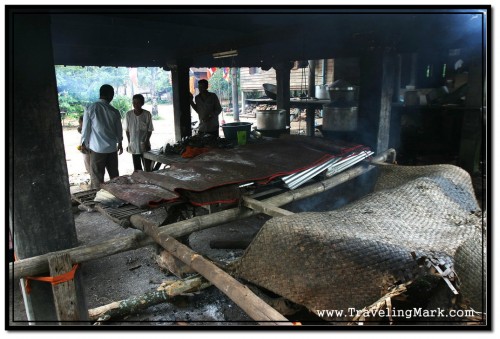
Language barrier was impenetrable as all of the locals under that roof were aged males who could not even read or write in their native tongue, nevermind understanding foreign languages. Since my understanding of Khmer language was virtually none, any form of verbal communication was impossible. It hindered me not.
I noticed a pile of green rolls on an improvised table next to the fire. These people were obviously cooking something and wrapping it up in banana leaves to serve as food. Smiles on their faces made me feel welcome so I took pictures of what was going on and one of the men picked up one of those a leaf wrapped rolls, unwrapped it and handed it to me with a smirk and a sign to give it a bite.
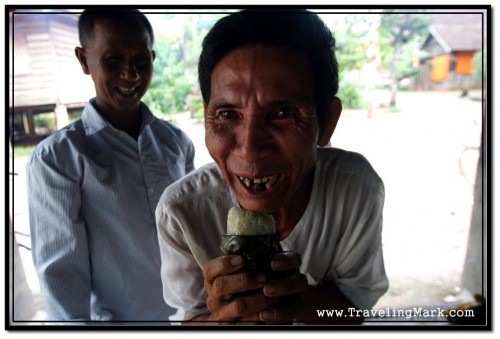
Once unwrapped, I could see that it’s a rice roll that perfectly sticks together and is wrapped tightly in a banana leaf giving it almost an impression of vacuum packing. As I learned later, these were Sticky Rice Cakes (referred to in Khmer as nom ansom) and they can really stay preserved inside that banana leaf for a good month without going bad, even when stored in permanently hot environments (Most rural Cambodians don’t even have electricity, nevermind fridges).
I took that Sticky Rice Cake that was so graciously offered to me and gave it a bite. It tasted awful. It was bland and tasteless. It felt like some mass in my mouth, but it had no taste. They obviously did not add any salt or other seasoning to it so the mass lacked any taste whatsoever. Inside the rice roll was a filling. The one I started to eat had meat filling, quite possibly pork – from the looks of it. The filling was as tasteless as the rice. I was not used to eating tasteless foods prior to coming to Cambodia which made it increasingly difficult for me to enjoy it. Regardless, these men who were cooking Sticky Rice Cakes within the Wat Bo temple grounds obviously did not sport the financial riches and simple foods, such as a Sticky Rice Cake was often all they could afford to eat. And they graciously offered me one to eat right on the spot. This act of unconditional generosity was so heart-warming I got over the taste lacking sticky rice and continued pretending that I enjoyed offered cake immensely.
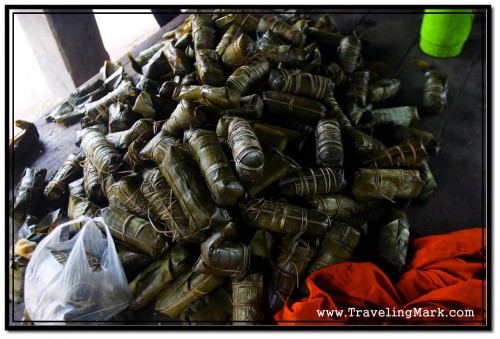
I wanted to ask what exactly these sticky rice cakes were, what exactly the filling was, how exactly they make them and whether I can leave a contribution to Wat Bo but language barrier made it impossible. And before I knew it, the man who unwrapped the sticky rice cake I was eating, already had a small plastic bag filled with about a dozen of those sticky rice cakes and handed it to me with a smile. I was trying to explain that I could not possibly accept that, seeing how these men barely had enough for themselves, but as I was talking, they kept smiling at me like the nicest people in the world, not understanding a single word I said. I did not know what to do next.
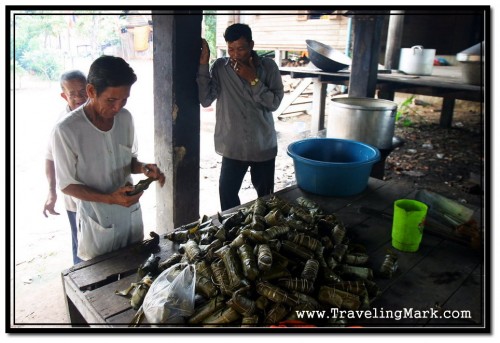
I really did not want to leave with so many rice cakes from people who obviously don’t belong anywhere near the middle class, yet I had no means to explain this to them. On the other hand, simply leaving the bag there and taking off would be extremely rude as it may make them feel like I despise them and/or their food. Without the ability to explain my thinking in words, I was in a dead lock. Last thing I wanted was to offend these genuinely nice people who don’t have much for themselves, but did not hesitate to share with a random stranger. This pile of sticky rice cakes they have just cooked may have been the food for all of the pagoda for a month. Now I was gonna leave with a dozen of the cakes I didn’t even like the taste of. But they looked so happy to have shared it with me I could not disappoint them.
I spent a little bit of time with them, slowly biting off from the sticky rice cake I had unwrapped trying to make it look like I enjoyed the taste and later made a move towards main Wat Bo pagoda to take pictures of it. I took the plastic bag filled up with still wrapped sticky rice cakes, made a hand sign that I’m going that way to take some pictures and took off without saying good bye. I still had it in my mind that as I’m taking pictures of the pagoda, I will work out the strategy to give these sticky rice cakes back to them as they’d serve them much better than they would serve me.
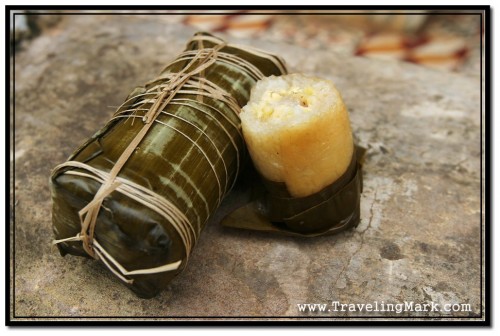
Wat Bo Stupas in Siem Reap, Cambodia Photo Gallery
Buddhism Stupas
My first exposure to Stupas was at Wat Preah Prom Rath in Cambodian Siem Reap. At that time I had no idea what these monumental structures within Buddhist pagodas were and why they ranged so much in size, color and shape. It was apparent that Stupas are an important part of Buddhism, I just didn’t know what purpose they served. When I got to Wat Bo in Siem Reap, the Stupas were more mesmerizing than the temple itself. That’s also one of the main reasons why I focused on Stupas and managed to miss historically and culturally important Reamker paintings. So what exactly are those Buddhist Stupas and why you always see them at Temple grounds?
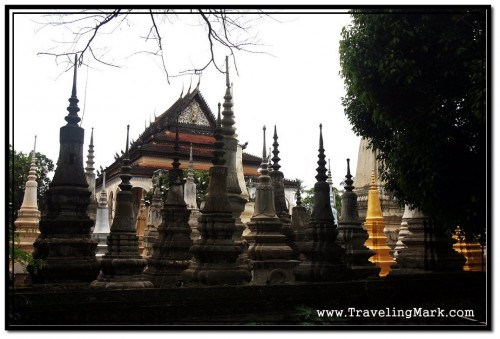
I saught answers with one of my students from the English language class at Wat Preah Prom Rath. I came to the pagoda about an hour prior to the lecture and one of the girls from the class was sitting there on the bench. Since I was entirely new to Buddhism, I asked around and she was most happy to explain. The only trick was that the class in which I was teaching was free for all, so students of all levels of English participated. The girl who was my Buddhism guide that day was a very beginner so language barrier was making it a bit difficult to understand each other.
From what I could make out, Stupas are used as graves. These monumental structures located near pagodas are basically tomb stones that house ashes of deceased Buddhists. The reason why some Stupas are bigger than other is wealth of a person or family whose ashes are housed inside. The wealthier a person, the fancier, bigger and more decorated a Stupa they can afford.
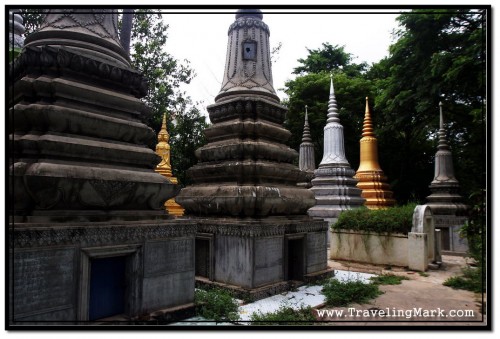
Stupas oftentimes have small entrance doorways through which ashes of other members of the same family are put inside. Through this door those who are still alive also put offerings for the dead, which include food for their journey through the afterworld, flowers, money and whatever other relics may be needed. Buddhists believe in reincarnation – death is not the end, only a transition.
In Buddhism, aside from practical use as funerary monuments, Stupas are best described as sacred monuments that symbolize enlightenment. Stupas have square bases which symbolize four immesurables as taught by Buddhism. The immeasurables are:
- Immeasurable love
- Immeasurable compassion
- Immeasurable joy
- Immeasurable equanimity
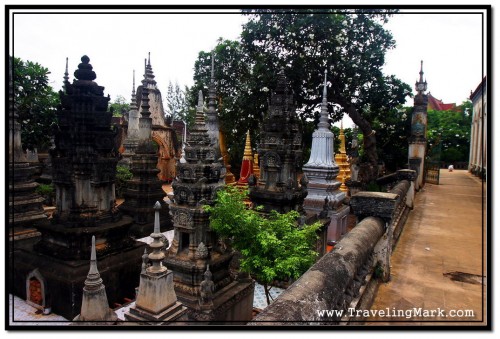
There is deep meaning to each part of Stupas. They are full of relics and holy objects, decorated with reliefs of important Buddhist events. There is powerful spirituality to each Stupa which is instantly recognized by merely looking upon one. I was drawn to those upon each encounter in Cambodia, Vietnam and Thailand. Very powerful, mesmerising monuments that establish peace and harmony and keep negative forces at bay.
RELATED GALLERY:
Wat Bo Stupas in Siem Reap, Cambodia Photo Gallery
Wat Bo Temple in Siem Reap, Cambodia
I was in Siem Reap, Cambodia for the same very reason every other tourist makes it there – Angkor Wat temples. However I was in no rush to get to Angkor but most of all, I did not limit my stay to merely exploring Angkor Archaeological area and moving on. I really wanted to savour the atmosphere of Siem Reap and wanted to explore its hidden gems that may not attract many tourists, but are spectacular in their own way. Wat Bo temple was just like that.
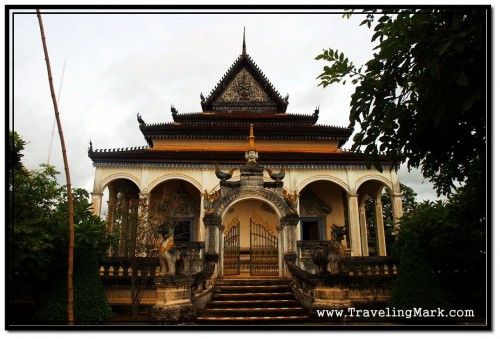
I used reference map in Siem Reap Angkor Visitors Guide to find locations of numerous temples located within Siem Reap town itself. Exploring Angkor Wat temples was to be a big adventure for which I wanted to get ready thoroughly (high cost for the entrance ticket was one of the main reasons) so to get accustomed to local climate, customs and everything else, I used the initial days in Siem Reap to explore its own gems. According to the maps, Wat Bo was the closest temple to Two Dragons Guesthouse where I was staying so I made it my first destination on my “exploring the temples of Siem Reap” day.
Wat Bo is located on the east side of the Siem Reap River. Entire area around Wat Bo temple and along Wat Bo Road in Siem Reap is now known as “backpacker’s area” due to vast numbers of budget guesthouses and restaurants.
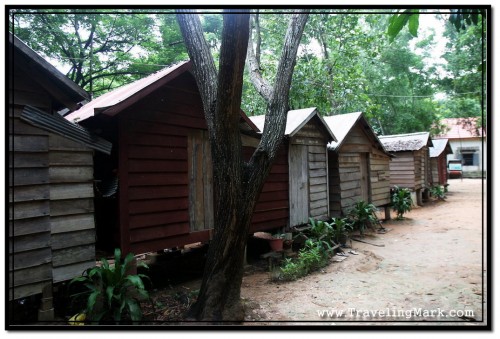
Other than Angkor temples, Wat Bo is one of the oldest pagodas in Siem Reap province. It was founded in the 18th century and to day it enjoys high regard among native Khmer population. The most significant part of Wat Bo are 19th century paintings depicting scenes from a Cambodian epic poem Reamker. As a traveller who never uses guides, whether it’s books or professional guide services, I have managed to miss out on Wat Bo’s Reamker entirely. I don’t even know where exactly these depictions are, I just know they are there. Darn, sometimes doing the research prior to going there pays off.
To my credit, other than Wat Preah Prom Rath pagoda, which is a modern, centrally located pagoda, Wat Bo was my first pagoda on my “exploring Siem Reap pagodas” tour. Wat Preah Prom Rath doesn’t count as I stumbled across it by chance, whether as visit to Wat Bo was planned and deliberate. Being my first, I was too overwhelmed with the vastness of the temple grounds and most of all – mesmerized by the number and variety of Stupas. At the time of my visit to Wat Bo, I had no idea what Stupas were, but as my day went on and I have visited other temples in Siem Reap, I learned all about it. More on Stupas in next post!
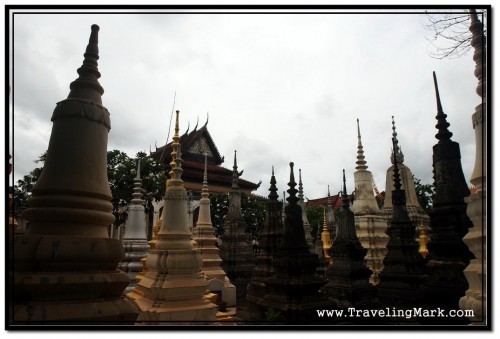
RELATED GALLERIES:
Phsar Kandal – Center Market in Siem Reap
As I was exploring Siem Reap on foot, I spent most of my time battling off ever aggressive Tuk Tuk drivers who kept approaching me on every step. It was early morning yet and my first day in Cambodia so I have immersed myself into the atmosphere and took on scorching rays of clouded sun. The rain has just stopped, but puddles have already been cleared off the roads and sidewalks by intense heat. The life around Siem Reap seemed to be in full swing despite early hour and all shops were open, inviting the visitors in. I figured it was time to confront the notorious Khmer cuisine which is said to be both delicious and inexpensive (translation: cheap). But first I wanted to pay a visit to Phsar Kandal (Center Market), an open market area which is said to be abundant with all sorts of trinkets I could care less for, but also fresh vegetables and fruit which is what I wanted to explore.
When you are traveling in countries with questionable health care, it is absolutely essential to ensure that you have proper intakes of vitamins and minerals to provide your body with means to battle potential issues before they develop into something more serious. Eating lots of fresh fruit and vegetables is often all it takes. It’s a delicious and inexpensive to not need a doctor. As a well aware tourist, heading to a closest market place (in this case Phsar Kandal aka Center Market) was a natural instinct which I have followed subconsciously.
I have crossed the bridge over Stung Siem Reap (Siem Reap River) which was labelled as Wat Bo Bridge by the Siem Reap Angkor Visitors Guide map I was following. The bridge was named after Wat Bo, a lovely pagoda bearing that same name. According to the map, Phsar Kandal (Center Market) was further up Samdech Tep Vong Street which is the street connected to the bridge I have just crossed. After the bridge, however I had faced a major challenge of crossing the road. It was suicidal to say the least and I have come to understand very quickly the very rule of driving in Cambodia – bigger has the right of way. No motor vehicle will attempt to stop, slow down or avoid you in any way if you are on the road. It’s your responsibility not to get killed. Cars and motorcycles will simply continue undeterred if there is someone hierarchically smaller in their way.
Despite slight difficulties, I have made it across the street without getting killed and paced forward to get to Center Market. It only takes a minute to get there as Siem Reap truly is a small town that can be easily done on foot but despite many stalls with fresh fruit, I felt discouraged and simply walked by without buying anything. Everyone seemed running towards me as soon as I have come to vicinity trying to force me into buying from them. Everyone at Phsar Kandal seems to keep approaching you, assuming that you are rich and can afford anything in the world. To top it up, there were no prices on anything displayed and having just lived my first minutes in Siem Reap, I knew I would get easily scammed if I were to buy anything at Phsar Kandal. I really wanted to, but not even slowing down seemed like an option as I would get swarmed by the vulture like people who would not let me go until they have squeezed the very last penny out of my pocket.
Despite true desire to bury my teeth into a juicy pineapple, I have simply walked by all the stalls and got nothing but a glace of luscious fruits laying on the tables. Had everyone left me alone and given me the room to breathe so I can take a closer look and decide unpressured, someone would have gotten business from me. But being jumped and repeatedly yelled at with offers of what I should buy from them and how they are gonna give me the best price ever and how I should buy after I come back from where I’m going if I’m not buying now, yadda yadda, I felt intimidated and pessimistic so ignoring entirely was the only option that lead to at least some sanity and peace of mind.
I continued on leaving Phsar Kandal behind me. The day was just dawning and I have just woke up to my first day in Cambodia. Surely there are safer places to buy fruit from. The ability to avoid hasty decision is one of the strongest assets a traveller to foreign countries can have. This time the prudence has prevailed. But Cambodia has introduced itself as pretty hostile country with extremely aggressive locals who stop at nothing to squeeze as much out of everyone who looks like a tourist as possible.
